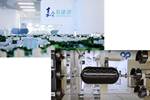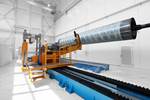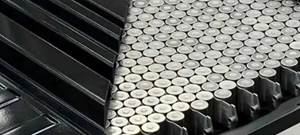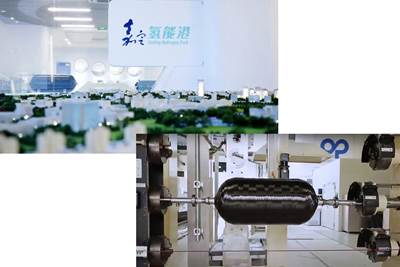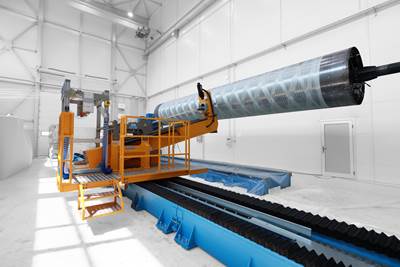Mikrosam equips BTU Germany with single-tape AFP head for Type 5 pressure vessels
Delivery of upgraded placement head provides additional automated layup flexibility, quality control for the university’s latest projects advancing Type 4 and 5 hydrogen storage.
Mikrosam (Prilep, Macedonia) has announced the delivery of its latest single-tape placement head to the Brandenburg University of Technology Cottbus - Senftenberg (BTU) in Germany, which is an upgrade to the existing robotic multi-tape automated fiber placement (AFP) work cell that Mikrosam delivered to the university 7 years ago. This equipment is specifically designed to meet the increasing demand for precision in automated composite layup processing of Type 5 hydrogen pressure vessels. Optimized for laboratory research and small-scale production, Mikrosam says it offers the flexibility required for producing complex, high-performance thermoplastic composite parts.
Mikrosam and BTU have a longstanding collaboration on R&D projects, consistently delivering proven results in the composite materials industry. In addition to the placement head, BTU uses a filament winding machine capable of wet and towpreg winding processes, and is equipped with in-house prepreg slitting and rewinding equipment, also manufactured by Mikrosam. This machine is designed to work with thermoset and thermoplastic prepregs to produce spools with various sizes and rewinding styles such as 300-millimeter-wide tape down to ¼-inch tapes used in the university’s existing AFP head, and now this new single-tape head. The solution enables on-demand use of prepreg slitting in different AFP processes.
Mikrosam’s single-tape placement head is engineered for automated layup on flat and complex, symmetrical or nonsymmetrical parts. Its compact design accommodates open and closed mandrel surfaces, making it ideal for cylindrical structures, pressure vessels, box beams and intricate parts with concave and convex geometries. Whether laying down thermoplastic prepreg tapes on flat surfaces or navigating the contours of small-diameter vessels (down to a 50-millimeter radius), the equipment is reported to excel in both capability and precision.
Notably, the flexible head is compatible with existing AFP systems, enabling seamless integration with Mikrosam’s composite manufacturing solutions. The tape placement technology and thermoplastic material are said to optimize the complete composite design because it can lay and reinforce every angle and portion of the part. This leads to efficient, lightweight solutions with an improved buy-to-fly ratio, also due to low process-related material scrap and material optimization.
Mikrosam’s head is an ideal addition to BTU’s R&D laboratory. With it, university researchers can now produce high-performance parts using a wide variety of thermoplastic prepregs, with the system supporting ¼-inch and ½-inch tape widths. These tapes are prepared using Mikrosam’s prepreg slitting and rewinding machine, ensuring precise material handling and preparation.
The compaction system uses a pneumatic roller, delivering 100-500 newton forces, ensuring consistent pressure throughout the layup process. A built-in cooling system helps maintain the roller and material temperature during continuous operation, improving both product quality and equipment durability. Mikrosam has designed the system to be user-friendly, with quick and easy tape and roller replacements to minimize downtime.
“The layup head is engineered and optimized to achieve a minimum 50-millimeter radius at vessel domes. To accomplish this, the vessel on the tailstock side is supported by rollers rather than a chuck, with long shafts used exclusively on the headstock side,” says Vele Samak, vice president at Mikrosam. “The heads itself is custom designed to produce Type 5 hydrogen pressure vessels in one single, continuous process using automated placement technology and thermoplastic prepregs. Its advanced controls enable real-time adjustments to tape placement angles and compaction forces, allowing users to optimize the process for various applications. BTU will now have the capability to develop and deliver one of the smallest Type 5 pressure vessels for hydrogen in the form of a sphere.”
Mikrosam also notes that it has equipped the AFP system with a range of features designed to enhance efficiency and quality. The latest model, for example, features a thermal camera that continuously monitors the layup process, providing real-time temperature data to ensure precise quality control. Additionally, the head is integrated with a high-precision knife system that enables on-the-fly tape cutting, reducing material waste and streamlining the production workflow. The MikroAutomate control system achieves continuous monitoring and real-time adjustments of key parameters such as tape tension and compaction force, and the QCS Quality Control System monitors and records all important process parameters, which can later be used for production historical overview and analysis.
Through the TransHyDE project, BTU’s chair of Polymer-Based Lightweight Design, alongside others, is currently researching technologies for the efficient transport of hydrogen for the Federal Republic of Germany. TransHyDE features several projects, each aiming to address a core issue of hydrogen transportation.
One of these projects is Mukran, in which the BTU chair is aiming to create hydrogen pressure vessels with innovative geometries to maximize transport efficiency. At the moment, Type 4 pressure vessels are manufactured with various technologies supplied by Mikrosam. The manufacture Type 4 vessels of particular shapes requires additional flexibility, which is where Mikrosam’s new single-tow head system will come into play. The BTU chair plans to test the capabilities of the AFP head in the manufacture of Type 5 pressure vessels.
Related Content
Composites end markets: Batteries and fuel cells (2024)
As the number of battery and fuel cell electric vehicles (EVs) grows, so do the opportunities for composites in battery enclosures and components for fuel cells.
Read MoreHexagon Purus opens new U.S. facility to manufacture composite hydrogen tanks
CW attends the opening of Westminster, Maryland, site and shares the company’s history, vision and leading role in H2 storage systems.
Read MoreUpdate: THOR project for industrialized, recyclable thermoplastic composite tanks for hydrogen storage
A look into the tape/liner materials, LATW/recycling processes, design software and new equipment toward commercialization of Type 4.5 tanks.
Read MoreRecycling end-of-life composite parts: New methods, markets
From infrastructure solutions to consumer products, Polish recycler Anmet and Netherlands-based researchers are developing new methods for repurposing wind turbine blades and other composite parts.
Read MoreRead Next
Plastic Omnium starts construction of Chinese mega-plant for H2 pressure vessels
The new PO-Rein joint venture factory in Jiading, Shanghai, aims to be operational in 2026, producing up to 60,000 hydrogen vessels and high-pressure hydrogen storage systems per year for the Chinese commercial vehicle market.
Read MoreCygnet Texkimp supplies filament winding cell to TWI Materials Integrity Centre
Versatile composites equipment will support the global R&T organization’s research and manufacturing of novel materials and parts for pressure vessels and pipes.
Read MoreMikrosam filament production line supports Amargo tank production
Mikrosam system features will support the production of Amargo’s chemically resistant pressure vessels or hydrogen storage in industrial plants.
Read More

